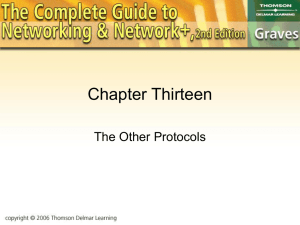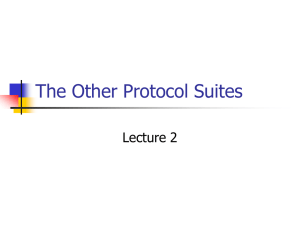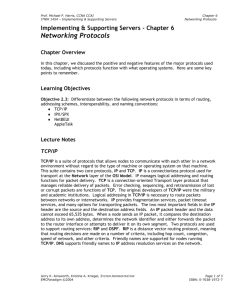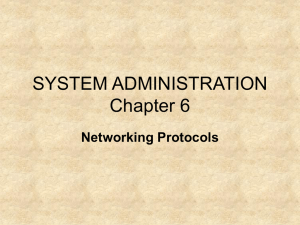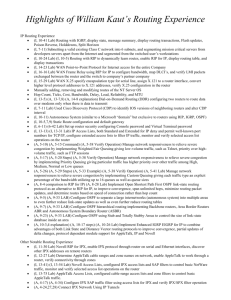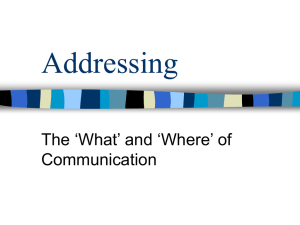Chapter 6
advertisement
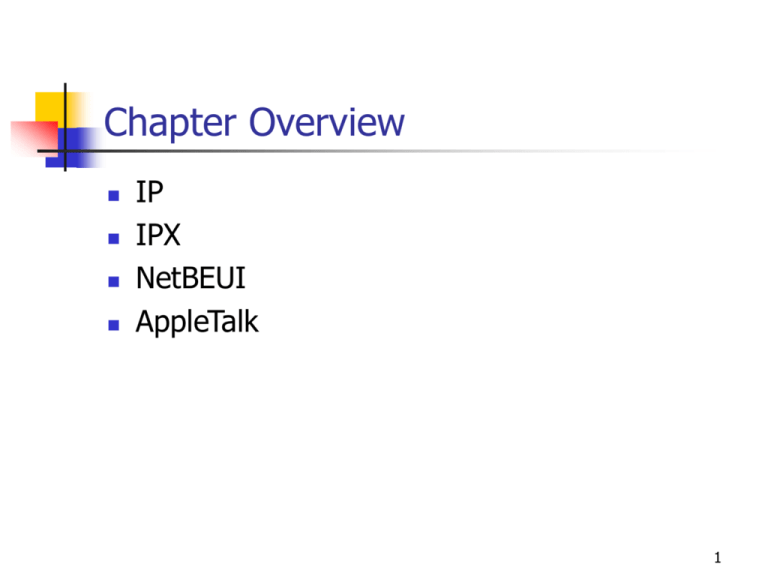
Chapter Overview IP IPX NetBEUI AppleTalk 1 Network Layer Protocols Responsible for end-to-end communications on an internetwork Contrast with data-link layer protocols, which provide communications on the same local area network (LAN) 2 IP Encapsulation 3 IP Functions Encapsulation – The packaging of the transport Layer data into a datagram Addressing – The identification of systems in the network using IP address Routing – The identification of the most efficient path to the destination system through the internetwork 4 IP Functions (Continue) Fragmentation – The division of data into fragments of an appropiate size for transmission over the network Protocol identification – The specification of the transport layer protocol that generated the data in the datagram. 5 The IP Datagram Format 6 IP Addresses Internet Protocol (IP) is the only network layer protocol with its own addressing system. IP addresses are 32 bits long. IP addresses have two parts: a network identifier and a host identifier. IP addresses are assigned to network interface adapters, not to computers. 7 IP Addresses (Continue) The Source IP Address field in the IP header always identifies the computer that generated the packet. The Destination IP Address field in the IP header always identifies the packet’s final destination. 8 End Systems and Intermediate Systems (IP Routing) ROUTERS Source and Final Destination Systems 9 Fragmentation Routers connect networks that support different-sized packets. The largest packet size supported by a network is called its maximum transmission unit (MTU). When a packet is too large to be forwarded to a particular network, the router splits it into fragments. 10 Fragmentation Fragmentation Each fragment is encapsulated with a header and is transmitted as a separate packet. Fragments are not reassembled until they reach their final destination. Fragments can themselves be fragmented. 11 Fragmentation (Cont.) 12 Protocol Field Values (The most commonly used values) 0 IP 1 ICMP 3 Gateway-to-Gateway Protocol (GGP) 6 TCP (most expected) 8 Exterior Gateway Protocol (EGP) 17 UDP (most expected) 13 The IPX Standard Developed by Novell for use with NetWare Proprietary; never published as a public standard Reverse engineered by Microsoft to create NWLink 14 IPX Functions Routing – Routes traffic between different types of Networks Addressing Protocol identification – Identifies the protocol that generated the data that it is carrying 15 The IPX Header Format 16 IPX Addressing IPX does not have its own addressing system Internet Packet Exchange (IPX) uses Separate node and network addresses Network interface adapter hardware addresses for node addresses Network addresses Are assigned by administrators Do not need to be registered 17 NetBEUI Characteristics Original Microsoft Windows default networking protocol Designed for small local area networks (LANs) Does not support Internet communications Does not need configuration Can be used to troubleshoot Transmission Control Protocol/Internet Protocol (TCP/IP) configuration protocols 18 NetBIOS Names Assigned to computers during Windows installation Sixteen characters long; the sixteenth character is a resource identifier Can identify computers, domain controllers, users, groups, and other resources Have no network identifier (which is why NetBEUI is nonroutable) 19 Comparison NetBEUI uses NetBIOS to identify computers on the Network IP uses IP addresses to identify computers on the Network IPX uses Hardware addresses to identify computers on the Network 20 The NBF (NetBEUI Frame) Protocol Format 21 Protocols Using NBF Name Management Protocol (NMP) Session Management Protocol (SMP) User Datagram Protocol (UDP) Diagnostic and Monitoring Protocol (DMP) 22 AppleTalk Data-Link Layer Options LocalTalk EtherTalk Fast EtherTalk TokenTalk FDDITalk 23 Datagram Delivery Protocol AppleTalk’s network layer protocol Provides packet addressing, routing, and protocol identification Has short-format and long-format packet headers 24 AppleTalk Addressing AppleTalk computers have a unique 8-bit node ID that is self-assigned. AppleTalk networks can have no more than 254 nodes. AppleTalk uses 16-bit network numbers for routing. Computers obtain network numbers using the Zone Information Protocol (ZIP). Computer processes are identified by 8-bit socket numbers. 25 AppleTalk Addressing (Cont.) Network numbers, node IDs, and socket numbers are expressed as three decimal numbers, separated by periods. AppleTalk computers resolve node IDs into hardware addresses, using the AppleTalk Address Resolution Protocol (AARP). AppleTalk computers also have friendly names and groups of computers called zones. 26 Chapter Summary Network layer protocols are responsible for endto-end communications across the network. IP is a connectionless protocol that encapsulates transport layer data into datagrams. IPX is a proprietary standard that performs routing, addressing, and protocol identification. NetBIOS Extended User Interface (NetBEUI) is used by small Windows networks for LAN networking. AppleTalk provides basic networking to small networks. 27
